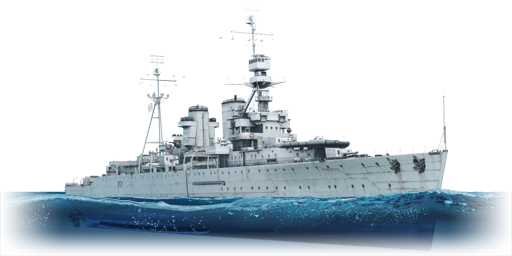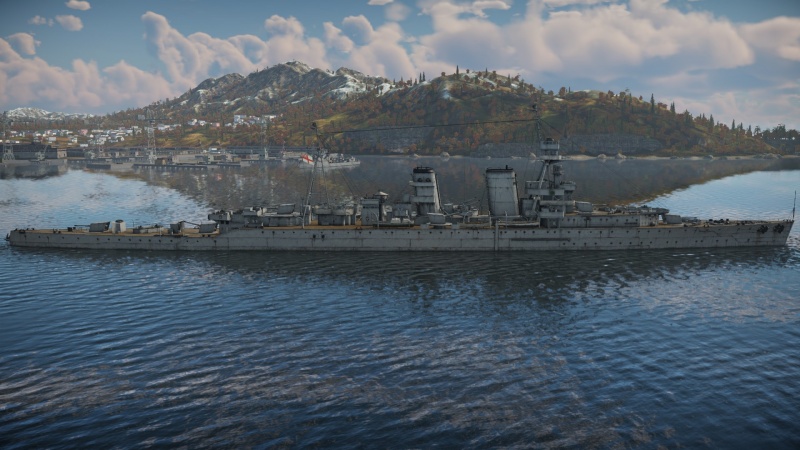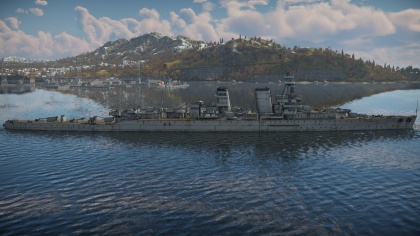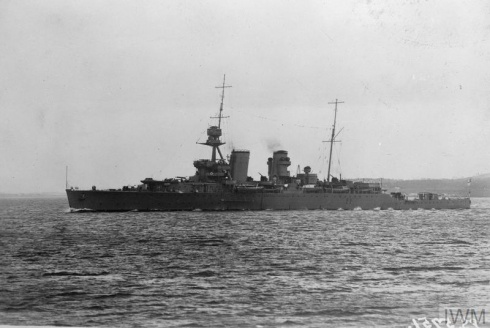Difference between revisions of "HMS Hawkins"
(Edits) |
|||
| Line 1: | Line 1: | ||
| − | {{Specs-Card|code=uk_cruiser_hawkins}} | + | {{Specs-Card |
| + | |code=uk_cruiser_hawkins | ||
| + | |images={{Specs-Card-Image|GarageImage_{{PAGENAME}}.jpg}} | ||
| + | }} | ||
== Description == | == Description == | ||
| Line 9: | Line 12: | ||
== General info == | == General info == | ||
=== Survivability and armour === | === Survivability and armour === | ||
| + | {{Specs-Fleet-Armour}} | ||
''Talk about the vehicle's armour. Note the most well-defended and most vulnerable zones, e.g. the ammo magazine. Evaluate the composition of components and assemblies responsible for movement and manoeuvrability. Evaluate the survivability of the primary and secondary armaments separately. Don't forget to mention the size of the crew, which plays an important role in fleet mechanics. Save tips on preserving survivability for the "Usage in battles" section. If necessary, use a graphical template to show the most well-protected or most vulnerable points in the armour.'' | ''Talk about the vehicle's armour. Note the most well-defended and most vulnerable zones, e.g. the ammo magazine. Evaluate the composition of components and assemblies responsible for movement and manoeuvrability. Evaluate the survivability of the primary and secondary armaments separately. Don't forget to mention the size of the crew, which plays an important role in fleet mechanics. Save tips on preserving survivability for the "Usage in battles" section. If necessary, use a graphical template to show the most well-protected or most vulnerable points in the armour.'' | ||
=== Mobility === | === Mobility === | ||
| + | {{Specs-Fleet-Mobility}} | ||
''Write about the ship's mobility. Evaluate its power and manoeuvrability, rudder rerouting speed, stopping speed at full tilt, with its maximum forward and reverse speed.'' | ''Write about the ship's mobility. Evaluate its power and manoeuvrability, rudder rerouting speed, stopping speed at full tilt, with its maximum forward and reverse speed.'' | ||
{{NavalMobility}} | {{NavalMobility}} | ||
| + | |||
| + | === Modifications and economy === | ||
| + | {{Specs-Economy}} | ||
== Armament == | == Armament == | ||
| + | {{Specs-Fleet-Armaments}} | ||
=== Primary armament === | === Primary armament === | ||
| + | {{Specs-Fleet-Primary}} | ||
{{main|7.5 inch/45 BL Mk.VI (190 mm)}} | {{main|7.5 inch/45 BL Mk.VI (190 mm)}} | ||
| Line 23: | Line 33: | ||
=== Secondary armament === | === Secondary armament === | ||
| + | {{Specs-Fleet-Secondary}} | ||
{{main|4 in QF Mark V (102 mm)}} | {{main|4 in QF Mark V (102 mm)}} | ||
| Line 28: | Line 39: | ||
=== Anti-aircraft armament === | === Anti-aircraft armament === | ||
| + | {{Specs-Fleet-AA}} | ||
{{main|2pdr QF Mk.VIII (40 mm)|20 mm/70 Oerlikon Mk.II (20 mm)}} | {{main|2pdr QF Mk.VIII (40 mm)|20 mm/70 Oerlikon Mk.II (20 mm)}} | ||
| Line 36: | Line 48: | ||
''Torpedo launchers are standard equipment on many ships and boats. Torpedoes are a significant means of defeating an opponent. Evaluate the position of the torpedo launchers, discuss the ammunition available, firing specifics such as dead zones, features of the torpedoes themselves, etc. If there is no torpedo armament, remove this section.'' | ''Torpedo launchers are standard equipment on many ships and boats. Torpedoes are a significant means of defeating an opponent. Evaluate the position of the torpedo launchers, discuss the ammunition available, firing specifics such as dead zones, features of the torpedoes themselves, etc. If there is no torpedo armament, remove this section.'' | ||
| + | |||
| + | === Additional armament === | ||
| + | {{Specs-Fleet-Additional}} | ||
| + | ''Describe the available additional armaments of the ship: depth charges, mines, torpedoes. Talk about their positions, available ammunition and launch features such as dead zones of torpedoes.'' | ||
| + | |||
| + | ''If there is no additional armament, remove this section.'' | ||
== Usage in battles == | == Usage in battles == | ||
Revision as of 11:58, 29 December 2020
Contents
Description
The Hawkins-class, HMS Hawkins (D86), 1942 is a rank III British heavy cruiser
with a battle rating of 5.0 (AB) and 5.3 (RB/SB). It was introduced in Update 1.93 "Shark Attack".
General info
Survivability and armour
Talk about the vehicle's armour. Note the most well-defended and most vulnerable zones, e.g. the ammo magazine. Evaluate the composition of components and assemblies responsible for movement and manoeuvrability. Evaluate the survivability of the primary and secondary armaments separately. Don't forget to mention the size of the crew, which plays an important role in fleet mechanics. Save tips on preserving survivability for the "Usage in battles" section. If necessary, use a graphical template to show the most well-protected or most vulnerable points in the armour.
Mobility
Write about the ship's mobility. Evaluate its power and manoeuvrability, rudder rerouting speed, stopping speed at full tilt, with its maximum forward and reverse speed.
| Mobility Characteristics | |||
|---|---|---|---|
| Game Mode | Upgrade Status | Maximum Speed (km/h) | |
| Forward | Reverse | ||
| AB | |||
| Upgraded | 64 | 22 | |
| RB/SB | |||
| Upgraded | 55 | 19 | |
Modifications and economy
Armament
Primary armament
Provide information about the characteristics of the primary armament. Evaluate their efficacy in battle based on their reload speed, ballistics and the capacity of their shells. Add a link to the main article about the weapon: {{main|Weapon name (calibre)}}. Broadly describe the ammunition available for the primary armament, and provide recommendations on how to use it and which ammunition to choose.
Secondary armament
Some ships are fitted with weapons of various calibres. Secondary armaments are defined as weapons chosen with the control Select secondary weapon. Evaluate the secondary armaments and give advice on how to use them. Describe the ammunition available for the secondary armament. Provide recommendations on how to use them and which ammunition to choose. Remember that any anti-air armament, even heavy calibre weapons, belong in the next section. If there is no secondary armament, remove this section.
Anti-aircraft armament
An important part of the ship's armament responsible for air defence. Anti-aircraft armament is defined by the weapon chosen with the control Select anti-aircraft weapons. Talk about the ship's anti-air cannons and machine guns, the number of guns and their positions, their effective range, and about their overall effectiveness – including against surface targets. If there are no anti-aircraft armaments, remove this section.
Torpedo armament
Torpedo launchers are standard equipment on many ships and boats. Torpedoes are a significant means of defeating an opponent. Evaluate the position of the torpedo launchers, discuss the ammunition available, firing specifics such as dead zones, features of the torpedoes themselves, etc. If there is no torpedo armament, remove this section.
Additional armament
Describe the available additional armaments of the ship: depth charges, mines, torpedoes. Talk about their positions, available ammunition and launch features such as dead zones of torpedoes.
If there is no additional armament, remove this section.
Usage in battles
Describe the technique of using this ship, the characteristics of her use in a team and tips on strategy. Abstain from writing an entire guide – don't try to provide a single point of view, but give the reader food for thought. Talk about the most dangerous opponents for this vehicle and provide recommendations on fighting them. If necessary, note the specifics of playing with this vehicle in various modes (AB, RB, SB).
Modules
| Tier | Seakeeping | Unsinkability | Firepower | |||
|---|---|---|---|---|---|---|
| I | Dry-Docking | Tool Set | 7.5 inch SAPC | 4 inch SAP | Anti-Air Armament Targeting | |
| II | Rudder Replacement | Fire Protection System | Smokescreen | 4 inch HE-TF | Auxiliary Armament Targeting | |
| III | Propeller Replacement | Shrapnel Protection | Ventilation | Improved Rangefinder | Primary Armament Targeting | |
| IV | Engine Maintenance | New Pumps | Ammo Wetting | Torpedo Mode | ||
Pros and cons
Summarise and briefly evaluate the vehicle in terms of its characteristics and combat effectiveness. Mark its pros and cons in the bulleted list. Try not to use more than 6 points for each of the characteristics. Avoid using categorical definitions such as "bad", "good" and the like - use substitutions with softer forms such as "inadequate" and "effective".
Pros:
Cons:
History
HMS Hawkins (D86) was the lead ship of the Hawkins-class of heavy cruisers. Launched in 1917, the ship would go on to serve as the flagship of the 5th Light Cruiser squadron based in the Eastern theatre, as well as the flagship of the 2nd Wing based in the Atlantic. In 1930, she was decommissioned, had her armament removed and became a training ship. However, she was recommissioned in 1939 with the outbreak of the Second World War. Hawkins served as a convoy escort ship and participated in the D-Day naval bombardment. In early 1945, Hawkins was placed in reserve; she served as a cadet training ship and a target ship, and was scrapped in mid-1947.[1]
Design and Construction
The Hawkins was the lead ship of the Hawkins-class of five heavy cruisers. Designed during the first half of WWI, the ships were designed as a series of fast, lightly-armoured heavy cruisers capable of hunting down similar German cruisers and commerce raiders of its era. By 1915, the design had been finalized, despite there being no need for a cruiser of its configuration due to the eradication of German commerce raiders.[2]
The ship was 184 metres long and displaced 12,190 tons full load.[1] Main armament consisted of seven 7.5-inch (190 mm) guns in single mounts - five were mounted on the centreline while two were mounted at the sides. The ships initially carried a mix of 76 mm and 2-pounder (40 mm) AA guns, but these were removed in later refits. Hawkins was also initially armed with a pair of triple torpedo tubes, but these were removed in 1937. The ship had light armour protection with a maximum thickness of 3 inches (76 mm), and could make 30 knots (55 km/h).[1]
Five ships of the Hawkins-class were ordered: Hawkins, Raleigh, Frobisher, Effingham and Cavendish. However, Cavendish was reconstructed during construction as an aircraft carrier and entered service as HMS Vindictive. HMS Hawkins was laid down on June 3rd 1916 and launched on October 1st 1917. She was completed and commissioned in July 1919.[2]
Operational Service
Following the completion of sea trials, Hawkins served as the flagship of the 5th Light Cruiser Fleet, based in the China Sea. She served in the Eastern Theatre until 1928, when she was transferred back to the Atlantic as the flagship of the 2nd Wing. In 1930, she was decommissioned and placed in reserve, where she was used by cadets of the Royal Navy for training purposes. In 1937, she had her 7.5-inch guns and torpedo tubes removed, as required by the London Naval Treaty.[1]
Upon the outbreak of the Second World War, Hawkins was recommissioned and had her main guns reinstalled. She was immediately deployed to the southern Atlantic, serving convoy escort duties. She served in the Indian ocean between 1942 and 1944, and captured many Axis merchantmen and freighters. She also served in the naval bombardment preceding the D-Day invasions.[1]
In August of 1944, Hawkins was again relegated to cadet-training units. She was placed into reserve and 1945, and served as a cadet training ship for an additional year. In 1947, she was used as a target ship for RAF bomb-dropping tests[2] and was scrapped shortly thereafter.[1]
Media
Excellent additions to the article would be video guides, screenshots from the game, and photos.
See also
Links to articles on the War Thunder Wiki that you think will be useful for the reader, for example:
- reference to the series of the ship;
- links to approximate analogues of other nations and research trees.
External links
References
Works Cited
- D-Day Encyclopedia. (n.d.). HMS Hawkins - Battle of Normandy. Retrieved November 16, 2020, from https://www.dday-overlord.com/en/material/warships/hms-hawkins
- Alvama. (1970, January 01). British heavy cruiser HMS Hawkins (D86) 1916-1947. Retrieved November 16, 2020, from http://warshipsresearch.blogspot.com/2017/05/british-heavy-cruiser-hms-hawkins-d86.html
| Britain heavy cruisers | |
|---|---|
| Hawkins-class | HMS Hawkins |
| York-class | HMS York |
| County-class | HMS Kent · HMS London · HMS Norfolk |







